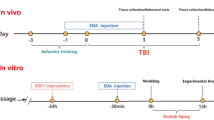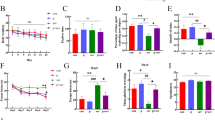Abstract
Cerebral ischemic stroke (CIS) has become the second leading cause of death worldwide, which is largely related to cerebral ischemia reperfusion injury (CIRI). Surgical intervention is a reliable treatment for CIS, which predictably causes cerebral reperfusion. Therefore, the choice of anesthetic drugs has important clinical significance. Isoflurane (ISO), one of the most used anesthetics, attenuates cognitive impairment and has brain protective effects. However, the role of isoflurane in regulating autophagy and its regulatory mechanism on inflammation in CIRI are still unclear. The middle cerebral artery occlusion (MCAO) method was used to establish a rat model of CIRI. After 24 h of reperfusion, all rats were evaluated by mNSS scoring and dark avoidance experiment. Western blotting and immunofluorescence were used to examine the expression of key proteins. Compared with the sham group, the MCAO group showed increased neurobehavioral scores and decreased cognitive memory function (P < 0.05). As for the ISO-treated MCAO rats, the neurobehavioral score was significantly decreased, the expression of AMPK, ULK1, Beclin1, and LC3B was significantly increased, and the cognitive and memory functions were also significantly improved (P < 0.05). After inhibition of autophagy pathway or key protein AMPK in autophagy, neurobehavioral scores and protein expression of NLRP3, IL-1β, and IL-18 were significantly increased (P < 0.05). Isoflurane post-treatment may enhance autophagy by activating the AMPK/ULK1 signaling pathway and further inhibit the release of inflammatory factors from NLRP3 inflammasomes, thereby ameliorating neurological function and cognitive impairment and exerting a protective effect on the brain in CIRI rats.








Similar content being viewed by others
Availability of Data and Materials
The datasets used and/or analyzed in during the current study are available from the corresponding author on reasonable request.
References
Boya P, Reggiori F, Codogno P (2013) Emerging regulation and functions of autophagy. Nat Cell Biol 15(7):713–720. https://doi.org/10.1038/ncb2788
Burchell SR, Dixon BJ, Tang J, Zhang JH (2013) Isoflurane provides neuroprotection in neonatal hypoxic ischemic brain injury. J Investig Med 61(7):1078–1083. https://doi.org/10.2310/JIM.0b013e3182a07921
Chen L, Li L, Song Y, Lv T (2021) Blocking SphK1/S1P/S1PR1 signaling pathway alleviates lung injury caused by sepsis in acute ethanol intoxication mice. Inflammation. https://doi.org/10.1007/s10753-021-01490-3
Ge M, Yin J, Qin X, Zhai J, Shao X, Wang R, Fan S, Dai Z, Wang S, Li Y (2021) Isoflurane post-conditioning attenuates cerebral ischemia/reperfusion injury by reducing apoptotic through activating the BMP7/SMAD signaling pathway in rats. J Chem Neuroanat 112:101916. https://doi.org/10.1016/j.jchemneu.2020.101916
Ha S, Jeong S, Yi K, Chung K, Hong C, Kim S, Kim E, Yu S (2017) Phosphorylation of p62 by AMP-activated protein kinase mediates autophagic cell death in adult hippocampal neural stem cells. J Biol Chem 292(33):13795–13808. https://doi.org/10.1074/jbc.M117.780874
Hurley J, Young L (2017) Mechanisms of autophagy initiation. Annu Rev Biochem 86:225–244. https://doi.org/10.1146/annurev-biochem-061516-044820
Inoki K, Kim J, Guan K (2012) AMPK and mTOR in cellular energy homeostasis and drug targets. Annu Rev Pharmacol Toxicol 52:381–400. https://doi.org/10.1146/annurev-pharmtox-010611-134537
Jiang T, Yu J, Zhu X, Wang H, Tan M, Cao L, Zhang Q, Gao L, Shi J, Zhang Y, Tan L (2014) Acute metformin preconditioning confers neuroprotection against focal cerebral ischaemia by pre-activation of AMPK-dependent autophagy. Br J Pharmacol 171(13):3146–3157. https://doi.org/10.1111/bph.12655
Jiang T, Yu J, Zhu X, Zhang Q, Tan M, Cao L, Wang H, Shi J, Gao L, Qin H, Zhang Y, Tan L (2015) Ischemic preconditioning provides neuroprotection by induction of AMP-activated protein kinase-dependent autophagy in a rat model of ischemic stroke. Mol Neurobiol 51(1):220–229. https://doi.org/10.1007/s12035-014-8725-6
Lee J, Park S, Takahashi Y, Wang H (2010) The association of AMPK with ULK1 regulates autophagy. PloS one 5(11):e15394. https://doi.org/10.1371/journal.pone.0015394
Lei Q, Ma J, Zhang Z, Sui W, Zhai C, Xu D, Wang Z, Lu H, Zhang M, Zhang C, Chen W, Zhang Y (2021) Deficient Chaperone-Mediated Autophagy Promotes Inflammation and Atherosclerosis. Circ Res. https://doi.org/10.1161/circresaha.121.318908
Li X, Peng J, Pang J, Wu Y, Huang X, Li Y, Zhou J, Gu L, Sun X, Chen L, Vitek M, Jiang Y (2018) Apolipoprotein E-mimetic peptide COG1410 promotes autophagy by phosphorylating GSK-3β in early brain injury following experimental subarachnoid hemorrhage. Front Neurosci 12:127. https://doi.org/10.3389/fnins.2018.00127
Li Z, Huang Z, Zhang H, Lu J, Tian Y, Piao S, Lin Z, Bai L (2021) Moderate-intensity exercise alleviates pyroptosis by promoting autophagy in osteoarthritis via the P2X7/AMPK/mTOR axis. Cell Death Dis 7(1):346. https://doi.org/10.1038/s41420-021-00746-z
Lyden P, Buchan A, Boltze J, Fisher M (2021) Top priorities for cerebroprotective studies: a paradigm shift. Stroke:STROKEAHA121034947. https://doi.org/10.1161/strokeaha.121.034947
Nasoohi S, Simani L, Khodagholi F, Nikseresht S, Faizi M, Naderi N (2019) Coenzyme Q10 supplementation improves acute outcomes of stroke in rats pretreated with atorvastatin. Nutr Neurosci 22(4):264–272. https://doi.org/10.1080/1028415x.2017.1376928
Palomino-Antolin A, Narros-Fernández P, Farré-Alins V, Sevilla-Montero J, Decouty-Pérez C, Lopez-Rodriguez A, Fernández N, Monge L, Casas A, Calzada M, Egea J (2021) Time-dependent dual effect of NLRP3 inflammasome in brain ischemia. Br J Pharmacol. https://doi.org/10.1111/bph.15732
Peng L, Yin J, Ge M, Wang S, Xie L, Li Y, Si J, Ma K (2019) Isoflurane post-conditioning ameliorates cerebral ischemia/reperfusion injury by enhancing angiogenesis through activating the Shh/Gli signaling pathway in rats. Front Neurosci 13:321. https://doi.org/10.3389/fnins.2019.00321
Peng L, Yin J, Wang S, Ge M, Han Z, Wang Y, Zhang M, Xie L, Li Y (2019) TGF-β2/Smad3 signaling pathway activation through enhancing VEGF and CD34 ameliorates cerebral ischemia/reperfusion injury after isoflurane post-conditioning in rats. Neurochem Res 44(11):2606–2618. https://doi.org/10.1007/s11064-019-02880-8
Ping F, Zhang C, Wang X, Wang Y, Zhou D, Hu J, Chen Y, Ling J, Zhou J (2021) Cx32 inhibits the autophagic effect of Nur77 in SH-SY5Y cells and rat brain with ischemic stroke. Aging 13. https://doi.org/10.18632/aging.203526
Sheng R, Zhang T, Felice V, Qin T, Qin Z, Smith C, Sapp E, Difiglia M, Waeber C (2014) Preconditioning stimuli induce autophagy via sphingosine kinase 2 in mouse cortical neurons. J Biol Chem 289(30):20845–20857. https://doi.org/10.1074/jbc.M114.578120
Tian R, Mao G (2022) Ghrelin reduces cerebral ischemic injury in rats by reducing M1 microglia/macrophages. Eur J Histochem EJH 66(1). https://doi.org/10.4081/ejh.2022.3350
Wang J, Wang Y (2021) Circular RNA cerebellar degeneration-related protein 1 antisense RNA (Circ-CDR1as) downregulation induced by dexmedetomidine treatment protects hippocampal neurons against hypoxia/reoxygenation injury through the microRNA-28-3p (miR-28-3p)/tumor necrosis factor receptor-associated factor-3 (TRAF3) axis. Bioengineered https://doi.org/10.1080/21655979.2021.1999369
Wang S, Yin J, Ge M, Dai Z, Li Y, Si J, Ma K, Li L, Yao S (2016) Transforming growth-beta 1 contributes to isoflurane postconditioning against cerebral ischemia-reperfusion injury by regulating the c-Jun N-terminal kinase signaling pathway. Biomed Pharmacother 78:280–90. https://doi.org/10.1016/j.biopha.2016.01.030
Wen J, Xu B, Sun Y, Lian M, Li Y, Lin Y, Chen D, Diao Y, Almoiliqy M, Wang L (2019) Paeoniflorin protects against intestinal ischemia/reperfusion by activating LKB1/AMPK and promoting autophagy. Pharmacol Res 146:104308. https://doi.org/10.1016/j.phrs.2019.104308
Wu C, Chen M, Liu S, Yang T, Long L, Guan S, Chen C (2021) Bioactive flavonoids icaritin and icariin protect against cerebral ischemia-reperfusion-associated apoptosis and extracellular matrix accumulation in an ischemic stroke mouse model. Biomedicines 9(11). https://doi.org/10.3390/biomedicines9111719
Yang Y, Chen L, Si J, Ma K, Yin J, Li Y, Yang C, Wang S (2020) TGF-β3/Smad3 contributes to isoflurane postconditioning against cerebral ischemia-reperfusion injury by upregulating MEF2C. Cell Mol Neurobiol 40(8):1353–1365. https://doi.org/10.1007/s10571-020-00822-5
Yin J, Liu X, Wang R, Ge M, Xie L, Zhai J, Dai Z, Li Y, Wang S (2020) βIsoflurane postconditioning upregulates phosphorylated connexin 43 in the middle cerebral artery occlusion model and is probably associated with the TGF-1/Smad2/3 signaling pathway. Biomed Res Int 2020:3451215. https://doi.org/10.1155/2020/3451215
Yin J, Li J, Ren Y, Li Y, Wang R, Wang S, Zuo Y (2021) Dexmedetomidine and Netrin-1 combination therapy inhibits endoplasmic reticulum stress by regulating the ERK5/MEF2A pathway to attenuate cerebral ischemia injury. Front Neurosci 15:641345. https://doi.org/10.3389/fnins.2021.641345
Yu S, Liu S, Wang N, Yu D, Qin M, Wu J, Guan Q (2021) Novel insights into antidepressant mechanism of Kai Xin San formula: Inhibiting NLRP3 inflammasome activation by promoting autophagy. Phytomedicine : international journal of phytotherapy and phytopharmacology 93:153792. https://doi.org/10.1016/j.phymed.2021.153792
Yuan M, Ge M, Yin J, Dai Z, Xie L, Li Y, Liu X, Peng L, Zhang G, Si J, Ma K, Wang S (2018) Isoflurane post-conditioning down-regulates expression of aquaporin 4 in rats with cerebral ischemia/reperfusion injury and is possibly related to bone morphogenetic protein 4/Smad1/5/8 signaling pathway. Biomed Pharmacother Biomedecine pharmacotherapie 97:429–38. https://doi.org/10.1016/j.biopha.2017.10.082
Zhang G, Ge M, Han Z, Wang S, Yin J, Peng L, Xu F, Zhang Q, Dai Z, Xie L, Li Y, Si J, Ma K (2019) Wnt/β-catenin signaling pathway contributes to isoflurane postconditioning against cerebral ischemia-reperfusion injury and is possibly related to the transforming growth factorβ1/Smad3 signaling pathway. Biomed Pharmacother Biomedecine pharmacotherapie 110:420–30. https://doi.org/10.1016/j.biopha.2018.11.143
Zhang Q, Yin J, Xu F, Zhai J, Yin J, Ge M, Zhou W, Li N, Qin X, Li Y, Wang S (2021) Isoflurane post-conditioning contributes to anti-apoptotic effect after cerebral ischaemia in rats through the ERK5/MEF2D signaling pathway. J Cell Mol Med 25(8):3803–3815. https://doi.org/10.1111/jcmm.16282
Zhang T, Zhou B, Sun J, Song J, Nie L, Zhu K (2022) Fraxetin suppresses reactive oxygen species-dependent autophagy by the PI3K/Akt pathway to inhibit isoflurane-induced neurotoxicity in hippocampal neuronal cells. J Appl Toxicol 42(4):617–628. https://doi.org/10.1002/jat.4243
Zhang YJ, Guo WJ, Tang ZY, Lin HB, Hong P, Wang JW, Huang XX, Li FX, Xu SY, Zhang HF (2022) Isoflurane attenuates cerebral ischaemia-reperfusion injury via the TLR4-NLRP3 signalling pathway in diabetic mice. Oxid Med Cell Longev 2022:2650693. https://doi.org/10.1155/2022/2650693
Acknowledgements
First of all, a very sincere thanks to Sheng Wang and Jiangwen Yin for their contributions to the study design and data analysis. Second, thanks to Nian Li, Xu Zhang, and Xinlei Qin for their efforts in the implementation of the study. Finally, thanks to Ketao Ma, Yan Li, and Ruixue Wang for their guidance on experimental methods.
Funding
This work was supported by the National Natural Science Foundation of China (82,160,235 and 81,860,249), and the Scientific Research Project of Shihezi University (ZZZC2022070).
Author information
Authors and Affiliations
Contributions
Sheng Wang, Jiangwen Yin, and Jingwen Zhai contributed to the study design and revised the manuscript. Jingwen Zhai, Nian Li, and Xu Zhang conducted the experiment and collected and analyzed the data. Ketao Ma, Yan Li, Ruixue Wang and Xinlei Qin provided assistance in experiment performing. Jingwen Zhai and Nian Li wrote the manuscript. All authors reviewed and approved the final manuscript.
Corresponding authors
Ethics declarations
Ethics Approval and Consent to Participate
The present study was approved by the Animal Experimentation Committee of the First Affiliated Hospital, School of Medicine, Shihezi University.
Consent for Publication
Not applicable.
Competing Interests
The authors declare no competing interests.
Additional information
Publisher's Note
Springer Nature remains neutral with regard to jurisdictional claims in published maps and institutional affiliations.
Jingwen Zhai and Nian Li have contributed equally to this work.
Rights and permissions
Springer Nature or its licensor (e.g. a society or other partner) holds exclusive rights to this article under a publishing agreement with the author(s) or other rightsholder(s); author self-archiving of the accepted manuscript version of this article is solely governed by the terms of such publishing agreement and applicable law.
About this article
Cite this article
Zhai, J., Li, N., Zhang, X. et al. Isoflurane Enhances Autophagy by Activating AMPK/ULK1, Inhibits NLRP3, and Reduces Cognitive Impairment After Cerebral Ischemia–Reperfusion Injury in Rats. J Mol Neurosci 73, 549–562 (2023). https://doi.org/10.1007/s12031-023-02135-w
Received:
Accepted:
Published:
Issue Date:
DOI: https://doi.org/10.1007/s12031-023-02135-w




